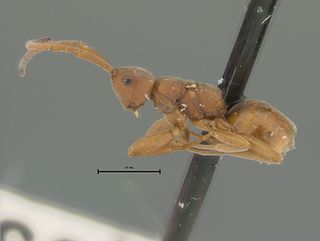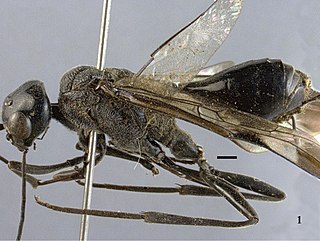
Dryinidae is a cosmopolitan family of solitary wasps. Its name comes from the Greek drys for oak: Latreille named the type genus Dryinus because the first species was collected on an oak tree in Spain. The larvae are parasitoids of the nymphs and adults of Auchenorrhyncha. Dryinidae comprises over 1900 described species, distributed in 11 extant subfamilies and 57 genera.

Ismarus is a genus of wasps belonging to the family Ismaridae, and presently the sole extant genus in the family. About 50 species are known in this small relictual group, all of which appear to be hyperparasitoids that parasitize Dryinidae.

Dryinus grimaldii is an extinct species of wasp in the dryinid genus Dryinus. The species is solely known from the early Miocene, Burdigalian stage, Dominican amber deposits on the island of Hispaniola.

Dryinus rasnitsyni is an extinct species of wasp in the dryinid genus Dryinus. The species is solely known from the early Miocene, Burdigalian stage, Dominican amber deposits on the island of Hispaniola.

Deinodryinus? aptianus is an extinct species of Deinodryinus in the wasp family Dryinidae. The species is solely known from a Cretaceous fossil found in Mongolia.

Deinodryinus areolatus is an extinct species of Deinodryinus in the wasp family Dryinidae. The species is solely known from an Eocene fossil found in the Baltic region.

Deinodryinus velteni is an extinct species of Deinodryinus in the wasp family Dryinidae. The species is known solely from an Eocene fossil found in the Baltic region.

Anteoninae are a subfamily of Dryinidae. There are 4 extant and 2 fossil genera, including Anteon. Characteristics of the subfamily include a 'mask' covering the frontal region of the larvae, an absence of cephalic vesicles, body folded in a U-shape, always found on the thorax or between metathorax and abdomen of the host, never between abdominal segments, with the subfamilial characteristics of mature larvae being "very long setae on body and head, (2) labrum with few long sensory bristles and two sensory pits at about mid-length between anterior and posterior margin and with an apical row of sensory bristles inserted immediately under its apical margin, (3) epipharynx with two sensilla, (4) labium subtriangular with narrow subquadrate spinneret, (5) spiracles bulb-shaped, of approximately equal size in thorax and abdomen, and (6) cocoon in the ground, covered by soil particles."
Thaumatodryinus tuukkaraski is a wasp species in the family Dryinidae. This tiny insect is endemic to Kenya where it is only known from the Taita Hills. In 2015, this newly discovered species was named in direct reference to former Boston Bruins (NHL) goaltender, Tuukka Rask.

Gonatopus is a genus of solitary wasps of the family Dryinidae, sometimes called hump-backed pincer wasps. The wingless females have large scissor-like appendages at the tips of the front legs which are used to catch the leafhopper nymphs which act as hosts to the larvae of these wasps. The larva consumes the leafhopper nymph from the inside. An indication that a leafhopper is hosting a grub is a cyst of accumulated shed integuments which surround and protect the growing wasp larva.

Embolemidae is a family of small solitary parasitoid wasps with around 70 species in 2 genera distributed around the world. The few species whose biology is known are parasites on planthopper nymphs of the families Achilidae and Cixiidae. There is debate regarding the status of the genus named Ampulicomorpha by Ashmead in 1893, generally considered now to be a junior synonym of Embolemus (e.g.,), though some authorities dispute this (e.g.,)

Aulacus is a genus of aulacids, ensigns, and gasteruptiids in the family Aulacidae. There are 77 species of Aulacus.
Ismaridae is a family of insects belonging to the order Hymenoptera. About 50 species are known in this small relictual group; all the species for which the biology is known appear to be hyperparasitoids that parasitize Dryinidae.

Dryinus is a cosmopolitan genus of dryinid parasitic wasp. Over 242 species have been described worldwide. Numerous fossil species have been described from the Baltic, Dominican and Burmese ambers.
Jouault, Corentin; Rosse-Guillevic, Simon. "A new genus of praeaulacid wasp from the mid-Cretaceous Kachin amber (Myanmar)". Annales de Paléontologie. 109 (1): 102599. doi:10.1016/j.annpal.2023.102599.
Aphelopus is a genus of insects belonging to the family Dryinidae. It is recognizable by only one costal cell surrounded by pigmented veins.

Embolemus is a genus of wasps belonging to the family Embolemidae. There is debate regarding the status of the genus named Ampulicomorpha by Ashmead in 1893, generally considered now to be a junior synonym of Embolemus (e.g.,), as a few authorities dispute this (e.g.,).
Deinodryinus is a genus of wasps belonging to the family Dryinidae.
Embolemopsis is an extinct genus of wasps belonging to the family Embolemidae. Two species are known: the type species, E. baissensis from the Aptian Zaza Formation of Russia, and E. maryannae from the Barremian Wessex Formation of England.














